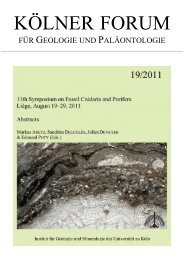Download (6Mb) - USP Electronic Research Repository - The ...
Download (6Mb) - USP Electronic Research Repository - The ...
Download (6Mb) - USP Electronic Research Repository - The ...
Create successful ePaper yourself
Turn your PDF publications into a flip-book with our unique Google optimized e-Paper software.
Benthic Marine Algae of Rotuma Island 379<br />
Womersley and Bailey 1970: 275; Dawes 1974: 75; Jaasund 1976: 27, fig. 53; Taylor 1977:<br />
8; Tsuda and Wray 1977: 94; Dong and Tseng 1984: 282, pl. 140, fig. 3; Payri and<br />
Meinesz 1985~: 507; Trono 1986: 216, figs 11, 12; South and Yen 1992: 127; Millar and<br />
Kraft 1994b: 438.<br />
Caulerpa peltata Lamouroux f. nummularia (Harvey) Dawson 1957: 106, fig. 10.<br />
Caulerpapeltata Lamouroux var. nummularia (Harvey) Weber-van Bosse 1898: 376.<br />
Caulerpa peltata Harvey (see Tsuda 1991: 41).<br />
(Figs 3 1, 37)<br />
Plants typically small and occurring as single stolons up to 1 mm in diameter,<br />
occasionally forming clumps 5-10 cm across of densely intermingled plants, each c. 8 cm<br />
long and sparingly provided with short rhizoidal branches. Spreading stolon bearing short<br />
cylindrical erect foliar axes 1-1.5 cm long at 2-3 mm intervals, these producing thin peltate<br />
discs 3-5 mm in diameter either singly at the end, or several discs axially arranged around<br />
the main foliar branches.<br />
Distribution<br />
Tropical oceans.<br />
Fijian Records<br />
Kasahara 1985: 30; Kasahara 1988; South 1991: 5; South and Kasahara 1992: 50; South<br />
and N'Yeurt 1993: 128, fig. 23.<br />
Rotuman Distribution<br />
Hapmafau (HAP81 <strong>USP</strong> 372); Lopta (L8); Maka Bay (MAK11 <strong>USP</strong> 371, MAKSI <strong>USP</strong> 369).<br />
Habitat and Remarks<br />
Typically found in cryptic locations, such as creeping over staghorn coral rubble or<br />
hidden under rocks on inner reef. Where it occurs in sheltered back reef sites (e.g.<br />
Hapmafau, Maka Bay) it can form distinct clumps or mats up to 15 cm diameter over sand-<br />
covered rocks or smooth substrata. Many plants examined showed distinct dent-like grazing<br />
marks on the disc edges.<br />
Sometimes classified as a separate species, there occurs a range of intermediate forms<br />
between Caulerpa racemosa var. peltata and var. turbinata. While the line of distinction<br />
between these forms varies amongst authors, the variety described here occupies the peltate<br />
extreme of the range, with unmistakable thin disc-like ramuli. <strong>The</strong>re is still debate as to<br />
whether the varietal status of C. racemosa var. peltata is valid, with some authors (e.g.<br />
Millar and Kraft 1994b) preferring to consider Caulerpa peltata a distinct species pending<br />
DNA studies on the type or authentic specimens.<br />
Caulerpa racemosa (Forsskbl) J. Agardh var. turbinata (J. Agardh) Eubank 1946: 420,<br />
fig. 20q; Dawson 1956: 35, fig. 16a; Taylor 1960: 152; Tsuda 1964: 5; Taylor 1977: 10;<br />
Lewis 1987: 24; Lewis and Norris 1987: 9; Silva et al. 1987: 108; Abbott 1989: 226;<br />
Coppejans and Beeckman 1989: 386, figs 24-26; Coppejans 1992: 401; Coppejans and<br />
Prud'homme van Reine 1992a: 174; 19926: 698, fig. 19A, B; South and N'Yeurt 1993: 129,<br />
fig. 24; Verheij and Prud'homme van Reine 1993: 124, pl. 2, fig. 6; Wynne 1993: 22.<br />
Caulerpa clavifera (Turner) C. Agardh var. turbinata J. Agardh 1837: 173 (type locality:<br />
near Tor, Sinai Peninsula, Egypt).<br />
Caulerpa chemnitzia (Esper) Lamouroux; Svedelius 1906; Durairatnam 1961: 28.<br />
Fucus chemnitzia Esper 1800: 167 (given as '127'), pl. LXXXVIII (type locality: Malabar<br />
Coast, India).

















